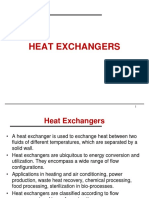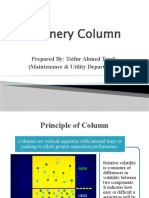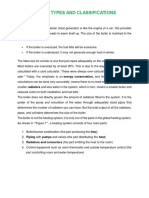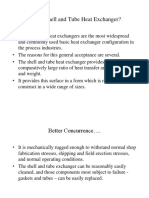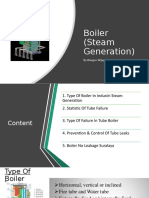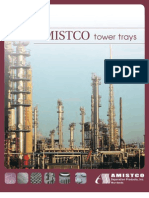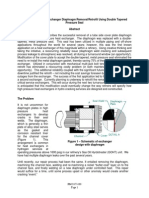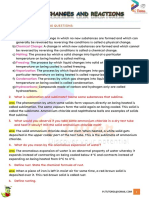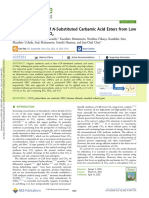0 ratings0% found this document useful (0 votes)
109 viewsFurnace
Furnace
Uploaded by
Waqas HassanThis document describes the restoration of refinery heaters using prefabricated ceramic fiber lined panels. This restoration technique addresses all problem areas that reduce heater efficiency, including casing hot spots, air leakage, corbel damage, flue gas obstruction, and dirty tubes. It allows for repairs to be made from inside the convection section. The restoration procedure involves dismantling the existing casing and refractory, hydroblasting the tubes, and installing prefabricated ceramic fiber panels within the normal turnaround period. This restoration technique has increased heater efficiency by over 3% at Exxon's Baton Rouge refinery while keeping turnaround times and costs comparable to conventional repairs.
Copyright:
Attribution Non-Commercial (BY-NC)
Available Formats
Download as PDF, TXT or read online from Scribd
Furnace
Furnace
Uploaded by
Waqas Hassan0 ratings0% found this document useful (0 votes)
109 views4 pagesThis document describes the restoration of refinery heaters using prefabricated ceramic fiber lined panels. This restoration technique addresses all problem areas that reduce heater efficiency, including casing hot spots, air leakage, corbel damage, flue gas obstruction, and dirty tubes. It allows for repairs to be made from inside the convection section. The restoration procedure involves dismantling the existing casing and refractory, hydroblasting the tubes, and installing prefabricated ceramic fiber panels within the normal turnaround period. This restoration technique has increased heater efficiency by over 3% at Exxon's Baton Rouge refinery while keeping turnaround times and costs comparable to conventional repairs.
Original Description:
Gives detail about furnace and its internal parts
Copyright
© Attribution Non-Commercial (BY-NC)
Available Formats
PDF, TXT or read online from Scribd
Share this document
Did you find this document useful?
Is this content inappropriate?
This document describes the restoration of refinery heaters using prefabricated ceramic fiber lined panels. This restoration technique addresses all problem areas that reduce heater efficiency, including casing hot spots, air leakage, corbel damage, flue gas obstruction, and dirty tubes. It allows for repairs to be made from inside the convection section. The restoration procedure involves dismantling the existing casing and refractory, hydroblasting the tubes, and installing prefabricated ceramic fiber panels within the normal turnaround period. This restoration technique has increased heater efficiency by over 3% at Exxon's Baton Rouge refinery while keeping turnaround times and costs comparable to conventional repairs.
Copyright:
Attribution Non-Commercial (BY-NC)
Available Formats
Download as PDF, TXT or read online from Scribd
Download as pdf or txt
0 ratings0% found this document useful (0 votes)
109 views4 pagesFurnace
Furnace
Uploaded by
Waqas HassanThis document describes the restoration of refinery heaters using prefabricated ceramic fiber lined panels. This restoration technique addresses all problem areas that reduce heater efficiency, including casing hot spots, air leakage, corbel damage, flue gas obstruction, and dirty tubes. It allows for repairs to be made from inside the convection section. The restoration procedure involves dismantling the existing casing and refractory, hydroblasting the tubes, and installing prefabricated ceramic fiber panels within the normal turnaround period. This restoration technique has increased heater efficiency by over 3% at Exxon's Baton Rouge refinery while keeping turnaround times and costs comparable to conventional repairs.
Copyright:
Attribution Non-Commercial (BY-NC)
Available Formats
Download as PDF, TXT or read online from Scribd
Download as pdf or txt
You are on page 1of 4
RESTORATION OF REFINERY HEATERS
USING THE TECHNIQUE OF PREFABRICATED CERAMIC FIBER LINED PANELS
Henry D. Sento
Exxon Co. U.S.A., Refining Department
Baton Rouge, Louisiana
ABSTRACT
Refinery heater fuel requirements often represent HEATER COMPONENTS
50% of ~ units operating cost. A one percent change
Before we proceed let's review the principal compo
in the efficiency of a heater firing 100 MBtu/hr
nents of a heater that are involved in the
amounts to more than $25,000 per year. Heater effi
restoration procedures.
ciency is influenced by casing hot spots, air leak
age, corbel damage, flue gas obstruction and dirty
tubes. Efficiency impact is greatest in the convec
tion section since conventional repairs only permit
TYPICAL REFINERY FURNACE
accessing from the outside, thus only hot spots and
some air leakage are repaired.
Exxon USA's Baton Rouge refinery has adopted a re
storation procedure, using the technique of ceramic
fiber lined panels, which corrects all the problem
areas and returns the heater to new condition. Res
torations have been successfully completed on con
vection sections as well as total heaters. All res
torations have been within a normal turnaround
period. Efficiency increases greater than 3% have
been realized, as well as improvements in the hea
ter's opera tion.
FLUE
GIIS
INTRODUCTION
-jtHH-CIlSTING
~ - 1 t H f + - - . REFRIICTORY
M---IH+1- CORBEL
9-iEEt---itt-H- TUBE S
Restoration of refinery heaters using the technique
END VIEW
of ceramic fiber lined panels is replacing conven
tional methods of repairing heaters at Exxon USA's
Baton Rouge Refinery. Restoration yields energy,
maintenance and operating dividends that normally are
not achieved with conventional repairs. These divi
o Casing
dends include reducing excess air, reducing setting
loss, reducing stack temperature and increasing the The casing covers the outside of the heater. It
heater capacity. In addition heater turnaround time seals the inside from the outside. The casing
is not extended and unscheduled heater maintenance should be air tight to prevent air from leaking
between turnarounds is greatly reduced or eliminated. into the heater or flue gas leaking out.
We will address the convection section in this dis
o Refractory
cussion, but it should be recognized that the resto
ration procedure can be applied to the entire beater.
The refractory is attached to the casing. It
insulates the heater against heat loss and
RESTORATION VS. CONVENTIONAL REPAIRS
protects the casing from the high flue gas
temperature. It should be tight and continuous
Limitations of conventional repairs are the result of
when the heater is in operation.
identifying and fitting work into a predefined turn
around schedule or squatting a unit to make a quick o The Corbels
repair. This is especially true for convection sec
The corbels are projections of the refractory,
tions. A typical conventional repair replaces the
a type of baffle that deflects a portion of the
apparent damaged refractory, patches casing and seal
flue gas over the convection tubes. The corbels
welds leaks. Little or no attention is given to the
are required for efficient heat transfer.
inside of the convection section. On the other hand
restoration addresses all problem areas that are re
lated to returning the convection section to new
condition as compared to the typical patch job.
24
ESL-IE-81-04-04
Proceedings from the Third Industrial Energy Technology Conference Houston, TX, April 26-29, 1981
o The Tubes
The tubes are the heat transfer medium. They
often have extended surfaces such as fins or
studs to increase their heat transfer capability.
The outside of the heat transfer surface
should be clean.
PROBLEM AREAS
The convection section has five distinct problem
areas, all of which have an impact on heater effi
ciency and operation. The areas and their impact
are:
o Casing Hot Spots - are the result of hot flue
gas contacting the casing because of refractory
failure. This causes loss of the casing and
possible weakening of structural members. In
addition, openings in the casing can increase
air infiltration.
o Air Leakage - is the result of air entering the
heater through openings in and around the
casing. This causes increased firing because
of heat required to raise the air temperature
as well as difficulty in furnace combustion
air control.
o Corbel Damage - is the result of refractory
failure and improper repair. This causes
flue gas bypassing the heat transfer surface
and excess energy going up the stack.
o Flue Gas Obstruction - is the result of debris
falling on the tubes during refractory repair
or build up of combustion products. This
causes draft loss which can reduce heater
capacity and result in operating the heater
under positive pressure.
o Dirty Tubes - are the result of deposition of
products of combustion on the outside of the
tubes. This causes a reduction in heat transfer
and increases energy loss to the stack.
TYPICAL CONVENTIONAL REPAIR
Let's return to our furnace section for a moment
to review a typical conventional repair.
TYPICRL REFINERY FURNRCE
REPRIR
POURING
CASTA8LE
H--<Jt+f-POURED CASTA8LE
OAM
FLUE
GAS
ENO VIEW
Prior to shut down inspection identifies hot spots
or casing irregularities and indicates repairs to
be made. A typical repair would require cutting'
out a section of the casing, inserting a plywood
dam and pouring castable refractory between the
plywood form and casing. Space limitations
usually result in elimination of corbels.
PROBLEM AREAS VS. REPAIRS/RESTORATION
As we just observed the conventional repair
addresses only two of the five problem areas.
Tube removal would be required to correct the
remaining three problem areas. However, from an
operating point of view this is usually not accept
able because tube pulling is costly and requires
more time than a normal shutdown or turnaround will
allow.
The restoration procedure used at the Baton
Refinery corrects all problem areas without
to remove the tubes. Restoration can be done wlth
in a normal turnaround schedule and often can be
done in less time than is required for extensiv
conventional repairs. '
RESTORATION PROCEDURE
Prior to taking a heater out of service all panels
are designed, engineered, and fabricated. This,
requires a period of four weeks to three
After shutdown the restoration procedure is simple
and consists of three basic activities. '
o First we dismantle all casing and
o Then the tubes are hydroblasted externally from
all angles. Hydroblasting returns the tubes:to
95-100% of new condition with respect to external
cleanliness. '
o Last measurements are checked and column joints
to which the panels will be fitted are installed.
The panels are then placed in position and seal
welded. This completes the job.
TYPICAL RESTORATION
These are Panels Being Shop
Prefabricated Prior to Turnaround
25
ESL-IE-81-04-04
Proceedings from the Third Industrial Energy Technology Conference Houston, TX, April 26-29, 1981
This is a convection section after dismantling This is a prefabricated panel being lifted
of the casing and refractory and hydroblasting of for installation. The corbelling can be
the tubes. Note the column preparation for seen on the surface of the panel.
joining the prefabricated panels.
The panels are delivered to the work site two
This is the panel in
structural columns.
place between the
It is now ready for
or three at a time. seal welding.
26
ESL-IE-81-04-04
Proceedings from the Third Industrial Energy Technology Conference Houston, TX, April 26-29, 1981
- -'
-.I
.'
KEY TO RESTORATION
Panel design is the key to restoration and the pre
fabricated ceramic fiber lined panel technique make
the design possible. Cermaic fiber has all of the
advantages of refractory without many of the dis
advantages such as quality control, dryout, and
expansion.
The use of ceramic fiber permits shop fabrication
of the panels prior to shutdown. The panels can
be fabricated at a remote site and safely stored
until needed.
The ceramic fiber permits ease of handling since
the fiber is flexible and weighs 75-90% less than
most refractory.
Ceramic fiber permits quick installation since only
compression joints are required for installation.
Also dryout and cracking are not problems.
Ceramic fiber also permits subsequent removal and
reuse of the same panels when it became necessary
to enter the convection section again.
TYPICAL PANEL DESIGN
This is a typical ceramic fiber lined panel design.
It illustrates the variables that are considered
in the design and how they are treated.
TYPICRL PRNEL DESIGN
o P.TTf\CHMENT STUDS
o Hf\RD
o
o CERf\M!C
o SS
o CERAMIC
o MP.ST1C
o NEW CP,SING
FOIL----------'
COP,T1NG -----------'
-----------
FACE ----,.;:::...:-"-
CORBEL -------'
In order of fabrication we have:
o A prefabricated steel panel adequately braced
and with lifting attachments installed. Studs
are welded to the panel for attachment of the
fiber system.
o A mastic coating is applied to inside sur
face to protect against dewpoint corrosion.
o Ceramic fiber is installed for insulating
purposes.
o A 2-3 mil stainless steel vapor barrier is
installed.
o Additional ceramic fiber is installed for
insulation.
o Last a layer of silicon impregnated ceramic
fiber is installed to protect against velociity
erosion and impingement. ,
o Corbelling is provided where required by i
installing additional strips of ceramic
ECONOMICS
Economics favor restoration based upon our
experience. This is best illustrated by a typiical
convection section restoration.
o -The cost estimated for conventional repairs:
was $95,000 as compared to an actual restora
tion cost $85,000. A difference of $10,000
in favor of restoration. i
o The estimated fuel savings from conventionali
1
repairs was 1.5% as compared to 4% for
restoration.
o The turnaround field labor estimated for conven
tional repairs were 4,'000 manhours compar:ed
575 hours for restoration. Restoratl0n
in reducing turnaround manhours 86%. '
SUMMARY I
Based upon our experience heater restoration
yielded several energy and operating credits
which were not available or minimal when using
conventional repair methods. These include:
I
o Increased heater efficiency resulted from t
sealing the casing, restoring corbelling
cleaning dirty tubes
I
o Improved operating reliability resulted
returning the convection secton to new
I
o Increased capacity resulted from reducing
flue gas pressure drop and increasing the oJt
side heat transfer coefficient !
o Future restoration is simplified because
prefabricated panels are easily removed and 1
can be reused
o Economic incentives offer energy savings, ,
increased heater capacity and minimized losti
production
FUTURE PLANS i
I
Future plans include designing removable
panels so restoration can be incorporated iutd any
routine turnaround or shutdown activities. I
i
27
ESL-IE-81-04-04
Proceedings from the Third Industrial Energy Technology Conference Houston, TX, April 26-29, 1981
You might also like
- S Announcement 20872 PDFDocument90 pagesS Announcement 20872 PDFHey YoNo ratings yet
- Aircraft Electrical and Electronics SystemDocument4 pagesAircraft Electrical and Electronics SystemPrakash Pant100% (1)
- Ice-Berg Theory of Strategic Focus and Value (Tesla Motors)Document6 pagesIce-Berg Theory of Strategic Focus and Value (Tesla Motors)Ariff Luqman100% (1)
- Crude Distillation UnitDocument2 pagesCrude Distillation Unitresure100% (1)
- Boilers & Fired Systems: Clean Coal TechnologyDocument47 pagesBoilers & Fired Systems: Clean Coal TechnologyfakharkhiljiNo ratings yet
- Bubble ColumnDocument34 pagesBubble ColumnAfroz MohammedNo ratings yet
- Refining Process (ARCHANA COMPLETE REFINING STUFF)Document96 pagesRefining Process (ARCHANA COMPLETE REFINING STUFF)Mahesh sinhaNo ratings yet
- 2017.08.28 - Gas - Liquid Contacting Equipments PDFDocument37 pages2017.08.28 - Gas - Liquid Contacting Equipments PDFdankshavali shaikNo ratings yet
- BubbleCap Distillation Manuals - FINAL 29082018 - 17PgsDocument17 pagesBubbleCap Distillation Manuals - FINAL 29082018 - 17PgsSagar MorjeNo ratings yet
- Vacuum Distillation: Mir Salman 2007-Chem-53 Usama Malik 2007-Chem-11 Sheraz Hussain 2007-Chem-31 Waseem Zia 2007-Chem-15Document14 pagesVacuum Distillation: Mir Salman 2007-Chem-53 Usama Malik 2007-Chem-11 Sheraz Hussain 2007-Chem-31 Waseem Zia 2007-Chem-15Usama Malik100% (3)
- PHT Unit-5 (THEORY)Document81 pagesPHT Unit-5 (THEORY)521 Balaji ONo ratings yet
- Column PresentationDocument27 pagesColumn PresentationTaifurNo ratings yet
- Atmospheric & Vacuum Distillation ProcessesDocument22 pagesAtmospheric & Vacuum Distillation ProcessesNikhil KumarNo ratings yet
- Unit 3. Furnaces: Professional Course in English "Process Technology. Equipment and Systems"Document20 pagesUnit 3. Furnaces: Professional Course in English "Process Technology. Equipment and Systems"Nathalia DelgadoNo ratings yet
- Distillation Column MaterialsDocument3 pagesDistillation Column Materialsramu karriNo ratings yet
- Furnaces PDFDocument6 pagesFurnaces PDFAlaa El-sherbinNo ratings yet
- Introduction To BoilersDocument36 pagesIntroduction To BoilersAdel SukerNo ratings yet
- Introduction To Distillation Operation, Control, and Troubleshooting Training Course For Refinery PersonnelDocument10 pagesIntroduction To Distillation Operation, Control, and Troubleshooting Training Course For Refinery PersonnelRASHEED YUSUFNo ratings yet
- Boiler Components FunctionDocument2 pagesBoiler Components FunctionMuhammad Adli Bin Ja'affarNo ratings yet
- CatalystDocument2 pagesCatalystchemistkamalNo ratings yet
- RefluxDocument1 pageRefluxJakub LuczakNo ratings yet
- Design Check List Viii-1 Rev0 InspectorDocument2 pagesDesign Check List Viii-1 Rev0 InspectorSHAJUNo ratings yet
- Improve Fired Heaters Reliability With Inclined Firing System LinkedInDocument65 pagesImprove Fired Heaters Reliability With Inclined Firing System LinkedInashutosh_garg_10100% (1)
- Chapter 5Document70 pagesChapter 5Husnain AliNo ratings yet
- Double Pipe Heat ExchangerDocument6 pagesDouble Pipe Heat ExchangerharisNo ratings yet
- AP Government GATE Online Classes: Heat TransferDocument88 pagesAP Government GATE Online Classes: Heat TransferRohan lallNo ratings yet
- Industrial Process FurnacesDocument5 pagesIndustrial Process FurnacesNoore Alam SarkarNo ratings yet
- DistillationDocument50 pagesDistillationSata AjjamNo ratings yet
- Air-Cooled Heat Exchangers: LectureDocument39 pagesAir-Cooled Heat Exchangers: LectureBaraa Shurbaji No 111No ratings yet
- GasketsDocument32 pagesGasketsرسول ناصر كريم خريبطNo ratings yet
- IRM2300 Lining Systems For Fired HeatersDocument23 pagesIRM2300 Lining Systems For Fired Heatersmika cabelloNo ratings yet
- Kurita Mitigating Coke FormationDocument3 pagesKurita Mitigating Coke FormationMarcelNo ratings yet
- Distillation TowwerDocument154 pagesDistillation TowwerAmmar HashimNo ratings yet
- Destilation Column InfoDocument33 pagesDestilation Column InfokumarNo ratings yet
- Chapter 2-1Document22 pagesChapter 2-1Fathi ShokryNo ratings yet
- Boiller Types Sabic PDFDocument40 pagesBoiller Types Sabic PDFMuhammad Hamza NaveedNo ratings yet
- Boilers: (Steam Generators)Document41 pagesBoilers: (Steam Generators)Das Jatinder KumarNo ratings yet
- Reboiler: Types of ReboilersDocument5 pagesReboiler: Types of ReboilersMigueAngelPFNo ratings yet
- Incinerator CDocument12 pagesIncinerator CArjun Shantaram ZopeNo ratings yet
- Furnace Common Operation IssueDocument7 pagesFurnace Common Operation Issue00083583rfNo ratings yet
- Distilasi Teori 2 (Coulson Bab 11)Document8 pagesDistilasi Teori 2 (Coulson Bab 11)Dewi ApriyaniNo ratings yet
- (Unit Operations Laboratory-2) : Name: Siraj Ali Aldeeb ID: 3214118Document7 pages(Unit Operations Laboratory-2) : Name: Siraj Ali Aldeeb ID: 3214118Siraj AL sharifNo ratings yet
- Distillation Column-3Document36 pagesDistillation Column-3Sana BashirNo ratings yet
- Distillation Application in PetroleumDocument46 pagesDistillation Application in Petroleumamirthalingam_b671No ratings yet
- N - Doped V2O5Document9 pagesN - Doped V2O5Amol VedpthakNo ratings yet
- Lec.1 Desalting ProcessDocument30 pagesLec.1 Desalting ProcessAhmed RedaNo ratings yet
- Heat Exchangers PDFDocument44 pagesHeat Exchangers PDFRajeevNo ratings yet
- Why A Shell and Tube Heat Exchanger?Document17 pagesWhy A Shell and Tube Heat Exchanger?Avishek KumarNo ratings yet
- Boiler (Steam Generation) KSDocument25 pagesBoiler (Steam Generation) KSBangun WijayantoNo ratings yet
- Fired Heater CO Emission Study ReportDocument15 pagesFired Heater CO Emission Study Reportchemical509No ratings yet
- Incinerator Bms Training July 2015Document33 pagesIncinerator Bms Training July 2015mir_zarrarNo ratings yet
- Industrial BoilersDocument81 pagesIndustrial BoilersRavi PrajapatiNo ratings yet
- TraysDocument8 pagesTraysAnonymous QM0NLqZONo ratings yet
- Activated Carbon From Jackfruit Peel Waste by H3PODocument13 pagesActivated Carbon From Jackfruit Peel Waste by H3POMaria De La HozNo ratings yet
- Multiphase Catalytic Reactors: Theory, Design, Manufacturing, and ApplicationsFrom EverandMultiphase Catalytic Reactors: Theory, Design, Manufacturing, and ApplicationsNo ratings yet
- Boiler Tube Failure and ImpactsDocument8 pagesBoiler Tube Failure and ImpactsUdhayakumar VenkataramanNo ratings yet
- Diaphragm Elimination Using Taper-Lok - NPRADocument11 pagesDiaphragm Elimination Using Taper-Lok - NPRAN. S. PanditNo ratings yet
- Diaphragm Elimination Using Taper-Lok - NPRADocument11 pagesDiaphragm Elimination Using Taper-Lok - NPRAAntonio PerezNo ratings yet
- Boiler SurveyDocument7 pagesBoiler SurveyrajishrrrNo ratings yet
- Boiler OverhaulDocument9 pagesBoiler OverhaulHemant Patil100% (1)
- Chemical & Mechanical DesignDocument39 pagesChemical & Mechanical DesignSenah DaunNo ratings yet
- Air Preheater Retrofit and EnhancementDocument9 pagesAir Preheater Retrofit and EnhancementVIBHAVNo ratings yet
- Photovoltaic Module Energy Yield Measurements Existing Approaches and Best Practice by Task 13 PDFDocument134 pagesPhotovoltaic Module Energy Yield Measurements Existing Approaches and Best Practice by Task 13 PDFDairo Ruiz LogreiraNo ratings yet
- Staffa Dual Displacement Hydraulic Motor: Kawasaki Motors Corp., U.S.ADocument12 pagesStaffa Dual Displacement Hydraulic Motor: Kawasaki Motors Corp., U.S.AUsama PopatiaNo ratings yet
- Suction Control Valve: Types HDKG85 and HDKO85Document2 pagesSuction Control Valve: Types HDKG85 and HDKO85seyedAli TabatabaeeNo ratings yet
- Grounding, Bonding and Nvent Erico Cadweld: Solutions GuideDocument160 pagesGrounding, Bonding and Nvent Erico Cadweld: Solutions GuideWaldir GavelaNo ratings yet
- F FL LO OW W: Vampire - Electronic IndicatorDocument3 pagesF FL LO OW W: Vampire - Electronic IndicatorscribdkhatnNo ratings yet
- Online Monitoring of Recip Compressors, 2004Document20 pagesOnline Monitoring of Recip Compressors, 2004peach5No ratings yet
- Class 12 - Physics (042)- Chennai Sahodaya - MS - SET 2Document6 pagesClass 12 - Physics (042)- Chennai Sahodaya - MS - SET 2Shivani Muralidharan100% (1)
- Gasna TurbinaDocument27 pagesGasna TurbinaivanmjwNo ratings yet
- Greenheck ManualDocument112 pagesGreenheck ManualArun Jacob CherianNo ratings yet
- DrillPipe, 80%, 5.875 OD, 0.500 Wall, IEU, S-135.. XT57 (7.000 X 4.250)Document3 pagesDrillPipe, 80%, 5.875 OD, 0.500 Wall, IEU, S-135.. XT57 (7.000 X 4.250)Garcia C L AlbertoNo ratings yet
- Raouf ICSOBADocument12 pagesRaouf ICSOBAPedro Milton ChibulachoNo ratings yet
- Changes and ReactionsDocument4 pagesChanges and ReactionsMayukh ChoudhuryNo ratings yet
- ETE 22628 Question Bank-UT1: Sr. No. Option 1 Option 2 Option 3 Oprtion 4 Answer KeyDocument6 pagesETE 22628 Question Bank-UT1: Sr. No. Option 1 Option 2 Option 3 Oprtion 4 Answer KeyAditya Panvalkar APNo ratings yet
- Tabla de Impedancia Cables Media TensionDocument7 pagesTabla de Impedancia Cables Media Tensionvcontrerasj72No ratings yet
- LE Q3 Science 4 Lesson 3 Weeks 6 8Document33 pagesLE Q3 Science 4 Lesson 3 Weeks 6 8Jaez Andrei SimborioNo ratings yet
- WHRB (HRSG) Performance CalculationsDocument9 pagesWHRB (HRSG) Performance CalculationsLiam Moylan100% (1)
- Investigating the Relationship Between Voltage Ratios and Coil Turns in a TransformerDocument12 pagesInvestigating the Relationship Between Voltage Ratios and Coil Turns in a TransformerbajirafNo ratings yet
- EA5010 Elements of Power SystemDocument2 pagesEA5010 Elements of Power Systemsaurabh.biet.11No ratings yet
- CVEN2101-Assignment BDocument32 pagesCVEN2101-Assignment BSamin JawalNo ratings yet
- Flow in Closed Conduits (Pipes)Document2 pagesFlow in Closed Conduits (Pipes)pratikNo ratings yet
- Vande Bharat CaseDocument34 pagesVande Bharat CaseKLN CHUNo ratings yet
- Acssuschemeng 2c00095Document10 pagesAcssuschemeng 2c00095Aitor PastorNo ratings yet
- UNIT I Microwave Transmission LinesDocument60 pagesUNIT I Microwave Transmission Lineskasireddy saibhargaviNo ratings yet
- Accident Statistics in Sri Lanka: A.K. SomasundaraswaranDocument3 pagesAccident Statistics in Sri Lanka: A.K. SomasundaraswaranSajith GamageNo ratings yet
- Design and Analysis of Assembly of Piston, Connecting Rod and Crank ShaftDocument8 pagesDesign and Analysis of Assembly of Piston, Connecting Rod and Crank ShaftMahavirsinh PadheriyaNo ratings yet
- The Animate and The Inanimate - CopieDocument77 pagesThe Animate and The Inanimate - CopieRohan KunwerNo ratings yet
- Lab 4: Handout Molecular Dynamics.: Recommended That You Read This LinkDocument22 pagesLab 4: Handout Molecular Dynamics.: Recommended That You Read This LinkshadrawsNo ratings yet
- Commissioning Test Auto Reclosing Paper IPTS 2013 Buayaem ENU PDFDocument9 pagesCommissioning Test Auto Reclosing Paper IPTS 2013 Buayaem ENU PDFnassarkiNo ratings yet
